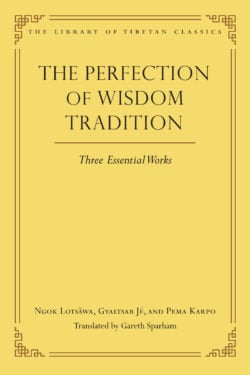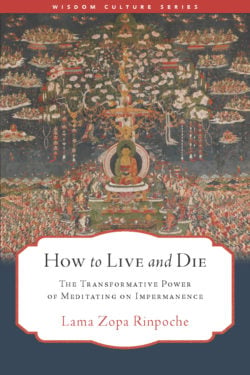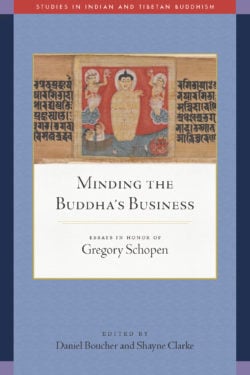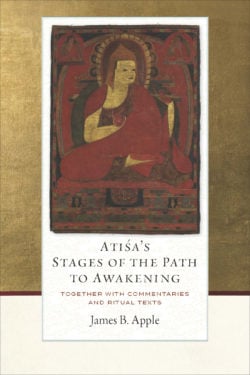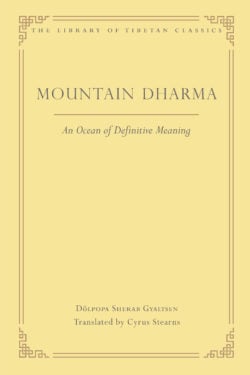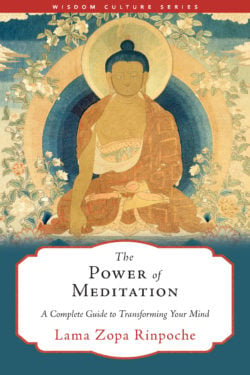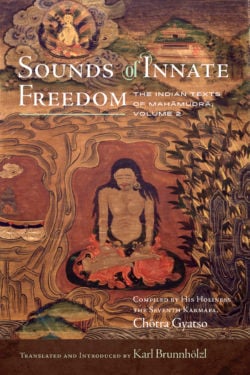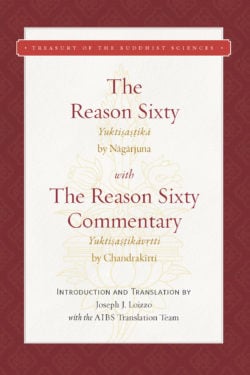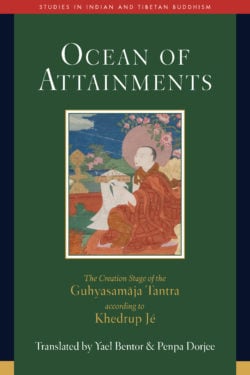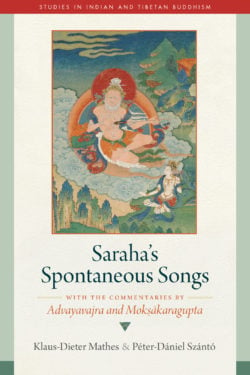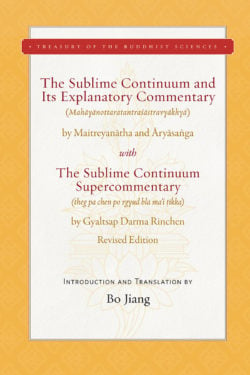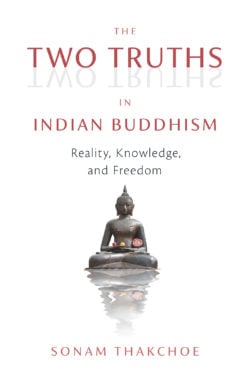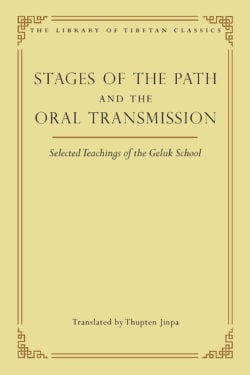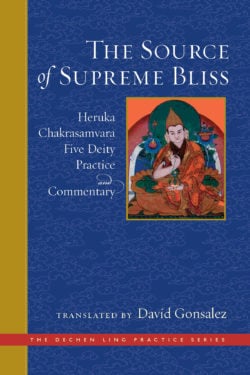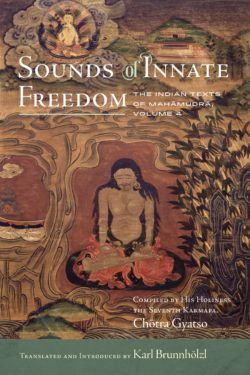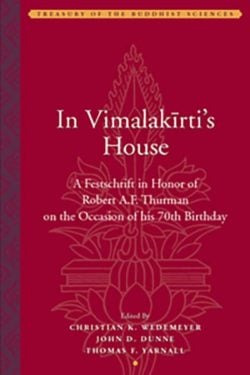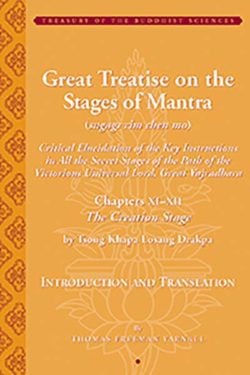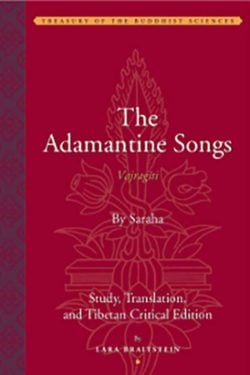
A HISTORY OF BUDDHISM IN INDIA AND TIBET
The first complete English translation of an important thirteenth-century history that sheds light on Tibet’s imperial past and on the transmission of the Buddhadharma into Central Asia.
Translated here into English for the first time in its entirety by perhaps the foremost living expert on Tibetan histories, this engaging translation, along with its ample annotation, is a must-have for serious readers and scholars of Buddhist studies. In this history, discover the first extensive biography of the Buddha composed in the Tibetan language, along with an account of subsequent Indian Buddhist history, particularly the writing of Buddhist treatises. The story then moves to Tibet, with an emphasis on the rulers of the Tibetan empire, the translators of Buddhist texts, and the lineages that transmitted doctrine and meditative practice. It concludes with an account of the demise of the monastic order followed by a look forward to the advent of the future Buddha Maitreya.
The composer of this remarkably ecumenical Buddhist history compiled some of the most important early sources on the Tibetan imperial period preserved in his time, and his work may be the best record we have of those sources today. Dan Martin has rendered the richness of this history an accessible part of the world’s literary heritage.
Learn more about the Library of Tibetan Classics
Learn about becoming a benefactor of the Library of Tibetan Classics
- Hardcover
- 984 pages, 6 x 9 inches
- $97.95
- ISBN 9780861714728
- eBook
- 984 pages
- $66.99
- ISBN 9781614297420
“This book is a treasure and a work of great service to those of us who are fascinated by Tibet’s history and culture. Martin’s translation—a massive achievement—allows readers to access a fascinating thirteenth-century Tibetan Buddhist history that has become a touchstone in Tibetan studies. The introduction is superb, and the notes throughout the work, in Martin’s inimitable voice, include some great insights into this text’s many delights and riddles.” —Brandon Dotson, associate professor and director, Department of Theology and Religious Studies, Georgetown University
“Dan Martin’s translation of this capacious history of Buddhism in India and Tibet is a veritable tour de force that has no rivals in the field of Indo-Tibetan Buddhist studies. Martin’s informative introduction reveals the depth and breadth of his own profound scholarship and illuminates the religious and socio-literary environment of Deyu’s work. One notices at every step Martin's exquisite control over the subject matter, and the copious notes that inform the translation never interfere with the text. This is a superb accomplishment!”—Leonard van der Kuijp, professor of Tibetan and Himalayan studies, Harvard University
“For those interested in understanding how Tibetans created a way of telling stories of the past that reflect Buddhist principles and thus continue to illuminate the present as well, this is an ideal place to start.” —Sam van Schaik, head of the Endangered Archives Programme at the British Library and author of Tibet: A History
"Dan Martin’s translation must be ranked among the foremost achievements of Tibetan historical studies. This important text is of great difficulty, peppered with obscure references and expressions, and is especially noteworthy for its detailed account of Tibet’s royal dynasties and their promotion of the Buddha’s teaching. Martin's work will be received as an inexhaustible gift to all students of Tibetan civilization, destined to be treasured as a standard work of reference for years to come."—Matthew T. Kapstein, professor emeritus, École Pratique des Hautes Études, Paris
Discover More
The Perfection of Wisdom Tradition
The perfection of wisdom (prajñāpāramitā) is a key element of the path in Mahāyāna Buddhism. Wisdom here is the transcendent wisdom of a bodhisattva who has penetrated the nature of reality, the emptiness (śūnyatā) of all things. Sutras that take the Perfection of Wisdom as their name emerged in the centuries before and after the start of the Common Era and became foundational for the nascent Mahāyāna. These include the well-known Heart Sūtra and Diamond Cutter Sūtra as well as the Perfection of Wisdom sutras in eight thousand and a hundred thousand lines.
Study of the Perfection of Wisdom sutras in Tibet has historically been through commentaries on the Ornament for the Clear Realizations (Abhisamayālaṃkāra), a short verse distillation in eight chapters attributed to Maitreya that was expanded in India by such figures as Asaṅga, Haribhadra, and Ārya-Vimuktisena. The three works in the present volume reflect the diversity of the Tibetan commentarial tradition on these Indian works.
Ngok Loden Sherab’s (1057–1109) Topical Summary marks the beginning in Sangphu Monastery of the most influential Perfection of Wisdom commentarial tradition. Ngok’s short work leads the reader briskly through the Abhisamayālaṃkāra’s seventy topics, presenting what would become the standard framework for explaining the Perfection of Wisdom in Tibet. The entirety of Haribhadra’s Vivṛti commentary has been embedded in Ngok’s text.
Gyaltsab Darma Rinchen’s (1364–1432) Way to Practice the Sequence of Clear Realizations, structured as a defense of the meditation system set forth by his guru Tsongkhapa in the Great Treatise on the Stages of the Path to Enlightenment, links the stages of the path expanded into the seventy topics with the actual practices of an accomplished yogi. Working outward from the middle of the Abhisamayālaṃkāra’s fourth chapter, it explains how the Perfection of Wisdom is integrated into a total and complete meditational practice for the attainment of buddhahood.
The great Drukpa Kagyü scholar Kunkhyen Pema Karpo’s (1527–92) Sacred Words of Lord Maitreya is the most detailed and systematic of the three works, supplementing explanations of the Perfection of Wisdom based on the Abhisamayālaṃkāra with verses from the Mahāyānasūtrālaṃkāra (Ornament for the Mahāyāna Sūtras) and the Uttaratantra (Sublime Continuum). This work as presented here includes within it a complete translation of the Abhisamayālaṃkāra’s eight chapters.
Learn more about the Library of Tibetan Classics
Learn about becoming a benefactor of the Library of Tibetan Classics
How to Live and Die
What death is, how we die, what minds we need at death and what happens after death—only by knowing about death and rebirth can we actually fully understand what life is and so learn how to live fully.
—Lama Zopa Rinpoche
There is arguably no truth more foundational to Buddhism than this: everything is impermanent. We can see this in the world all around us; old systems break down, relationships change. Death comes for those we love and, inevitably, for us.
In this book, the late, beloved teacher Lama Zopa Rinpoche walks us through the traditional, revelatory practices of meditating on the fact of impermanence and even—especially—on death itself. Rather than shy away from this reality, we look straight at it, and thus we learn not only how to not fear death, but how to live.
Minding the Buddha’s Business
Colleagues and former students of Gregory Schopen honor his path-breaking contributions to Buddhist studies with these articles on the early Mahayana, the monastic codes, and Buddhism’s art-historical and epigraphical remains.
This volume honors the profoundly transformative influence of Gregory Schopen’s many contributions to Buddhist studies. Eighteen articles by former students and colleagues focus on the areas of Schopen’s most noteworthy influence: the study of the Mahayana, particularly of its early sutra literature; the study of Vinaya, especially the narratives accompanying the rules for monks and nuns; and the study of Buddhist epigraphy and art history. Contributors demonstrate the ongoing significance of Schopen’s scholarship, including his very first article, on the cult of the book in the early Mahayana, published fifty years ago.
Schopen has repeatedly shown how the study of Buddhism has too often focused on scriptures and normative doctrines and not enough on the practical ideas and contexts that significantly impacted the lives of actual Buddhists. He sought to reveal these lived concerns in the massive trove of Buddhist inscriptions, which often expose the habits and ideas of the tradition’s most prominent donors (many of whom were monastics), as well as the everyday concerns of monks and nuns, whose views did not always dovetail with canonical sources. Even in his treatment of canonical sources, Schopen has shown that the standard portrait of a Buddhist monk or nun fails to match a careful reading of their law codes—his work on the Mulasarvastivada-vinaya has required scholars to substantially reimagine the legal and ritual obligations, as well as the economic concerns, that preoccupied the minds of Buddhist jurists.
Schopen has, in essence, brought the Buddha down to earth, revealing that this is precisely where most Indian Buddhists encountered him. The contributions in this celebratory volume reflect this legacy and Schopen’s considerable impact on our understanding of Buddhists in India.
Click here to see the table of contents.
Atiśa’s Stages of the Path to Awakening
This book contains a lost Stages of the Path (Lamrim) work composed by the originator of the genre, Atiśa, one of the greatest Indian Buddhist masters to ever set foot in Tibet.
Nearly a millennium ago, the great Indian Buddhist master Atiśa Dīpaṃkaraśrījñāna (ca. 982–1054) wrote a guidebook for realizing all the stages to awakening at the repeated request of his closest Tibetan disciple. Atiśa is famously the author of the Lamp for the Path to Awakening (Bodhipathapradipa), a short work in verse, but this longer prose work has been virtually unknown, even in Tibet—until now. Atiśa’s Stages of the Path Awakening (Bodhipathakrama), translated here, synthesizes all aspects of Buddhist practice, from the very beginning of the path—reflecting on the fortunate opportunity of human rebirth—up through to attaining omniscient buddhahood by nondual meditation. The Indian master’s faithful disciple Dromtönpa kept these teachings secret, and they were only transmitted to select disciples in a closely guarded transmission, but the lineage died out centuries ago, after Dromtönpa’s Kadam school was eclipsed by history.
Now this significant work of Buddhist path literature has become available owing to recently recovered manuscripts of the Kadampas. This book offers a study and complete translation from the Tibetan of this monument of guidance on the Buddhist path accompanied by the commentaries and ritual texts that were transmitted alongside Atiśa’s text. Apple’s substantial introduction includes a structural comparison with Atiśa’s famous work, charts the transmission lineage for the present work before it died out, and explores various hypotheses for why their fates diverged. Recovered from the contingencies of history, this book brings to life one of the most holistic and integrated approaches to the highest realizations of the Indian Buddhist path ever transmitted in Tibet.
Mountain Dharma
A brilliant annotated translation of Dölpopa Sherab Gyaltsen’s Mountain Dharma that opens a masterpiece of the Jonang tradition to Western readers and presents Dölpopa’s provocative ideas about a true, eternal, and established reality that still impact Buddhism today.
The controversial master Dölpopa Sherab Gyaltsen shook Buddhist Tibet when he taught that an eternal enlightened essence, or buddha nature, exists in full form in all living beings. The ideas discussed in Mountain Dharma are still as provocative as when Dölpopa first taught them, impacting Buddhism to this day. Dölpopa identified the ultimate with the buddha nature, or sugata essence, which he held to be eternal and not empty of self-nature. The buddha nature is perfect, with all its characteristics inherently present in all living beings. It is only the impermanent and temporary afflictions veiling the buddha nature that are empty of self-nature and must be removed through the practice of the path to allow it to manifest. Dölpopa establishes the validity of his theories with an ocean of quotations selected from Indian Buddhist scriptures and treatises of indisputable authority, showing us that the ultimate is a true, eternal, and established reality, empty merely of other relative phenomena.
Learn more about the Library of Tibetan Classics
Learn about becoming a benefactor of the Library of Tibetan Classics
The Power of Meditation
What is meditation, and how do we practice it?
In The Power of Meditation, Lama Zopa Rinpoche, beloved teacher and co-founder of the Foundation for the Preservation of the Mahayana Tradition, offers clear explanations and instructions for the life-changing practice of meditation.
From preparatory procedures, such as selecting a space and adopting the proper motivation, to the details of posture and how to focus the mind, Rinpoche offers step-by-step instruction that serves as both a starting point for beginners and a new vantage on familiar techniques for more experienced sitters. In his own direct and plain-spoken style, Rinpoche offers concise explanations for different kinds of meditation, such as shamatha, or calm abiding meditation, and vipashyana, or insight meditation, delineating their specific techniques and applications. And finally, Rinpoche presents tips for bringing our newfound clarity off of the cushion and into our daily lives, making each moment meaningful.
The Wisdom Culture Series, published under the guidance of Lama Zopa Rinpoche, provides English-language readers with key works for the study and cultivation of the Mahayana Buddhist path, especially works of masters within the lineage of Lama Tsongkhapa and the Geluk school of Tibetan Buddhism.
Sounds of Innate Freedom, Vol. 2
The second volume in a historic six-volume series containing many of the first English translations of the classic mahāmudrā literature compiled by the Seventh Karmapa.
Sounds of Innate Freedom: The Indian Texts of Mahāmudrā are historic volumes containing many of the first English translations of the classic mahāmudrā literature. The texts and songs in these volumes constitute the large compendium called The Indian Texts of the Mahāmudrā of Definitive Meaning, compiled by the Seventh Karmapa Chötra Gyatso (1456–1539). Translated, introduced, and annotated by Karl Brunnhölzl, acclaimed senior teacher at the Nalandabodhi community of Dzogchen Ponlop Rinpoche, the collection offers a brilliant window into the richness of the vast ocean of Indian mahāmudrā texts cherished in all Tibetan lineages, particularly in the Kagyü tradition, giving us a clear view of the sources of one of the world’s great contemplative traditions.
This volume 2 (thirty-four texts) contains two long-established sets of Mahāmudrā works: “The Sixfold Pith Cycle” and short texts of Maitrīpa’s “Twenty-Five Dharmas of Mental Nonengagement,” which present a blend of Madhyamaka, Mahāmudrā, and certain tantric principles, as well as two commentaries by Maitrīpa’s students. The vital focus of this volume is the accomplishment of true reality.
Click here to explore other volumes available in The Sounds of Innate Freedom series.
The Reason Sixty
The Reason Sixty: Second Edition presents two key Indian Buddhist philosophical masterpieces that integrate the Buddhist ethos of wisdom and compassion, with their profound relevance to contemporary thought clarified by a renowned scholar of contemplative science.
This volume contains English translations of two critical treatises of the Middle Way (Madhyamaka) Buddhist philosophical school: the Reason Sixty, by the most important of Indian thinkers Nāgārjuna (2nd century CE), and the commentary by his most influential successor, Chandrakīrti (7th century CE). These two treatises emphasize the non-foundationalist reasoning for which Madhyamaka thought is famed, here within the context of that quintessential Buddhist topic, universal compassion, thereby illuminating the nondual nature of these two fundamental components of Indian Buddhist thought. The full import of Nāgārjuna’s verses are brought to life by Chandrakīrti, whose influence in Tibetan Buddhist educational institutions remains profound to the present. Translator Joseph Loizzo, a Harvard-trained psychiatrist and Columbia-trained Buddhologist, elucidates the relevance of these two treatises to the linguistic turn in contemporary philosophy and emphasizes their practical, therapeutic possibilities. Comparing in particular the deep resonances between Chandrakīrti’s commentary and Wittgenstein’s later work, Loizzo presents a masterful analysis in cross-cultural thought that highlights the transformative potential of philosophy.
This volume is part of the Treasury of the Buddhist Sciences series, copublished by the American Institute of Buddhist Studies (AIBS) and Wisdom Publications in association with the Columbia University Center for Buddhist Studies and Tibet House US. You can learn more about the series here.
Ocean of Attainments
This commentary on Guhyasamāja tantra is the seminal guide to deity yoga and tantric visualization for the Geluk school of Tibetan Buddhism.
The Guhyasamāja Tantra, called the king of all tantras, is revered in Tibet, especially by the Geluk school. Ocean of Attainments, a commentary on Guhyasamāja practice, was composed by Khedrup Jé Gelek Palsang (1385–1438), a key disciple of the Geluk school founder, Tsongkhapa Losang Drakpa. It explores the creation stage, a quintessential Buddhist tantric meditation that together with the completion stage comprises the path of unexcelled tantra.
In the creation stage, meditators visualize themselves as buddhas at the center of the celestial maṇḍala, surrounded in all directions by male and female buddhas, bodhisattvas, and other enlightened beings. Yet creation-stage practice is not merely visualization but deity yoga—indivisibly uniting the meditation on emptiness with the visualization of the maṇḍala. The creation stage uses the conceptualization in visualization to overcome conceptualization, thereby creating a nonconceptual and nonerroneous direct perception. Such a mind, profound and vast, can bring about a transformation that stops saṃsāric suffering. How can visions generated as mental constructs not be erroneous? To the awakened eye, the buddhas and other beings who dwell in the maṇḍala are “reality,” and in a sense they are more than real.
While the previously published Essence of the Ocean of Attainments is a concise exposition on the practice of the Guhyasamaja sadhana, Ocean of Attainments is far more detailed, providing extensive scriptural citations, clear explanation of the body maṇḍala, arguments on points of contention, reference to other tantric systems, and critiques of misinterpretations. With its extensive and clear introduction, this volume is a vital contribution to the growing body of scholarship on Guhyasamāja and on Buddhist tantra in general.
Learn more about the Studies in Indian and Tibetan Buddhism series.
Saraha’s Spontaneous Songs
“Completely abandon thought and no-thought, and abide in the natural way of a small child.” —Saraha
To find liberation and realize the true nature of reality, the Indian Buddhist master Saraha says we must leave behind any conceptual assessment of reality, since no model of it has ever been known to withstand critical analysis. Saraha’s spontaneous songs, or dohās, represent the Buddhist art of expressing the inexpressible. The most important collection of Saraha’s songs is the Dohākoṣa, the Treasury of Spontaneous Songs, better known in Tibet as the Songs for the People, and the Tibetan mahāmudrā tradition, especially within the Kagyü school, has done the most to preserve the lineage of Saraha’s instructions to the present day.
But Saraha was also widely cited in Indian sources starting around the eleventh century, and one Indic commentary, by the Newar scholar Advayavajra, still exists in Sanskrit. In addition, we have independent root texts of Saraha’s songs in the vernacular Apabhraṃśa in which they were recorded. These Indian texts, together with their Tibetan translations, are here presented in masterful new critical editions, along with the Tibetan translation of the commentary no longer extant in Sanskrit by Mokṣākaragupta. Finally, both commentaries are rendered in elegant English, and the authors offer a brisk but comprehensive introduction.
Saraha’s Spontaneous Songs provides the reader with everything needed for a serious study of one of the most important works in the Indian Buddhist canon.
Learn more about the Studies in Indian and Tibetan Buddhism series.
The Sublime Continuum and Its Explanatory Commentary
The original Sublime Continuum Explanatory Commentary was written by Noble Asanga to explain the verses received from the bodhisattva Maitreya in the late fourth century CE in northern India. Here it is introduced and presented in an original translation from Sanskrit and Tibetan, with the translation of an extensive Tibetan Supercommentary by Gyaltsap Darma Rinchen (1364–1432), whose work closely followed the view of his teacher, Tsong Khapa (1357–1419).
Contemporary scholars have widely misunderstood the Buddhist Centrist (Madhyamaka) teaching of emptiness, or selflessness, as either a form of nihilism or a radical skepticism. Yet Buddhist philosophers from Nagarjuna on have shown that the negation of intrinsic reality, when accurately understood, affirms the supreme value of relative realities. Gyaltsap Darma Rinchen, in his Supercommentary, elucidates a highly positive theory of buddha nature, showing how the wisdom of emptiness empowers the compassionate life of the enlightened, as it is touched by its oneness with the truth body of all buddhas. With his clear study of Gyaltsap’s insight and his original English translation, Bo Jiang completes his historic project of studying and presenting these works from Sanskrit and Tibetan in both Chinese and, now, English translations, in linked publications.
The Two Truths in Indian Buddhism
In this clear and exemplary approach to one of the core philosophical subjects of the Buddhist tradition, Sonam Thakchoe guides readers through the range of Indian Buddhist philosophical schools and how each approaches the two truths: ultimate truth and conventional truth. In this presentation of philosophical systems, the detailed argumentations and analyses of each school’s approach to the two truths are presented to weave together the unique contributions each school brings to supporting and strengthening a Buddhist practitioner’s understanding of reality. The insights of the great scholars of Indian Buddhist history—such as Vasubandhu, Bhāvaviveka, Kamalaśīla, Dharmakīrti, Nāgārjuna, and Candrakīrti—are illuminated in this volume, with profound implications to the practice and views of modern practitioners and scholars.
The Vaibhāṣika, Saūtrāntika, Yogācāra, and Madhyamaka schools provide a framework for a continuum of philosophical debate that is far more interrelated, and internally complex, than one may presume. Yet we see how the schools build upon the findings of one another, leading from a belief in the realism of external phenomena to the relinquishment of any commitment to realism of either external or internal realities. This fascinating movement through philosophical approaches leads us to see how the conventional and ultimate—dependent arising and emptiness—are twin aspects of a single reality.
Stages of the Path and the Oral Transmission
A major contribution to the literature on Buddhist practice according to the Geluk school of Tibetan Buddhism from its foremost interpreter.
Although it was the last major school to emerge in the Tibetan Buddhist tradition, the Geluk school has left an indelible mark on Buddhist thought and practice. The intellectual and spiritual brilliance of its founder, the great Tsongkhapa (1357–1419), has inspired generations of scholars and tantric yogis to place him at the heart of their daily meditative practice. The Geluk tradition’s close ties to the Dalai Lamas have also afforded it an outsized influence in all aspects of Tibetan life for centuries. At its peak, its combined monasteries boasted a population in the tens of thousands, and its sway encompassed the religious landscape of Mongolia and much of Central Asia.
This widespread religious activity fostered a rich literary tradition, and fifteen seminal works are featured here representing four genres of that tradition. The first are works on the stages of the path, or lamrim, the genre for which the Geluk is most renowned. Second are works on guru yoga, centered around the core Geluk ritual Offering to the Guru (Lama Chöpa). Third are teachings from the unique oral transmission of Geluk mahāmudrā, meditation on the nature of mind. Fourth are the “guide to the view” (tatri) instructions. The volume features well-known authors like Tsongkhapa, the First Panchen Lama, and the Fifth Dalai Lama, but also important works from lesser-known figures like Gomchen Ngawang Drakpa’s stages of the path in verse and Gyalrong Tsultrim Nyima’s extensive commentary on the Lama Chöpa that interweaves precious explanations from the Ensa Oral Tradition he received from his own teacher.
Your guide to these riches, Thupten Jinpa, maps out their historical context and spiritual significance in his extensive introduction.
Learn more about the Library of Tibetan Classics
Learn about becoming a benefactor of the Library of Tibetan Classics
The Source of Supreme Bliss
The Source of Supreme Bliss contains the first English translations of important commentaries on the Highest Yoga Tantra system of the Heruka Chakrasamvara five deity practice.
Included is a lucid, practical, and deeply profound explanation of the generation stage by Ngulchu Dharmabhadra. This is followed by an extremely rare and profound commentary by the First Panchen Lama Losang Chökyi Gyaltsen on the completion stage, along with a commentary on how to perform a proper Chakrasamvara retreat. The second half of the book comprises translations of the ritual texts associated with the commentaries.
Indispensable for anyone who undertakes this practice, The Source of Supreme Bliss will also provide rich and profound insights for those interested in Highest Yoga Tantra.
The Dechen Ling Practice Series from Wisdom Publications is committed to furthering the vision of David Gonsalez (Venerable Losang Tsering) and the Dechen Ling Press of bringing the sacred literature of Tibet to the West by making available many never-before-translated texts.
Sounds of Innate Freedom, Vol. 4
Sounds of Innate Freedom: The Indian Texts of Mahāmudrā are historic volumes containing many of the first English translations of classic mahamudra literature. The texts and songs in these volumes constitute the large compendium called The Indian Texts of the Mahāmudrā of Definitive Meaning, compiled by the Seventh Karmapa, Chötra Gyatso (1456–1539). The collection offers a brilliant window into the richness of the vast ocean of Indian mahamudra texts cherished in all Tibetan lineages, particularly in the Kagyü tradition, giving us a clear view of the sources of one of the world’s great contemplative traditions.
Besides the individual dohās (couplets), vajragītis (vajra songs), and caryāgītis (conduct songs) in this second volume in publication, the three extensive commentaries it contains brilliantly unravel enigmas and bring clarity not only to the specific songs they comment on but to many other, often cryptic, songs of realization in this collection. These expressive songs of the inexpressible offer readers a feast of profound and powerful pith instructions uttered by numerous male and female mahāsiddhas, yogis, and ḍākinīs, often in the context of ritual gaṇacakras and initially kept in their secret treasury. Displaying a vast range of themes, styles, and metaphors, they all point to the single true nature of the mind—mahāmudrā—in inspiring ways and from different angles, using a dazzling array of skillful means to penetrate the sole vital point of buddhahood being found nowhere but within our own mind. Reading and singing these songs of mystical wonder, bliss, and ecstatic freedom, and contemplating their meaning, will open doors to spiritual experience for us today just as it has for countless practitioners in the past.
Click here to explore other volumes available in The Sounds of Innate Freedom series.
In Vimalakīrti’s House
Over the course of nearly half a century, Robert A. F. Thurman has left an indelible mark on numerous fields of study, including Buddhist literature, Tantric Buddhism, Tibetan studies, and the comparative sciences of mind. To celebrate his seventieth birthday, Thurman’s students and colleagues have come together to pay tribute to these contributions and to Thurman’s ongoing leadership in these fields by assembling a collection of essays of their own that extend and supplement his groundbreaking research.
In Vimalakīrti’s House is the result of this collaboration and represents a broad spectrum of cutting edge studies in areas central to Thurman’s own scholarly project. The resulting volume is itself a kind of “treasury of the Buddhist sciences,” insofar as its authors explore wide-ranging problems in art, literature, epistemology, history, ritual, buddhology, and lexicography.
Great Treatise on the Stages of Mantra (Sngags rim chen mo)
Tsong Khapa’s Great Treatise on the Stages of Mantra (Sngags rim chen mo)—considered by the present Dalai Lama to be one of Tsong Khapa’s two most important books (along with his Lam rim chen mo)—is his masterful synthesis of the principles and practices of all four classes of Tantra, which formed the basis of his innovation in creating the esoteric “Tantric College” institution and curriculum in the early fifteenth century. With detailed reference to hundreds of works from the Tibetan Kangyur and Tengyur, the chapters presented and studied in this volume concern his treatment of the creation stage (bskyed rim) meditations of Unexcelled Yoga Tantra. This includes a detailed analysis emphasizing how and why such creation stage practices—utilizing deity yoga to transform death, the between, and life into the three bodies of buddhahood are indispensible to creating a foundation for successfully entering the culminal yogic practices of the perfection stage. (A subsequent volume will present the perfection stage chapters of this essential masterwork.)
An important work for both scholars and practitioners, this annotated translation is supplemented with extensive support materials.
The Adamantine Songs (Vajragīti)
Presented here in English for the first time is a set of three of Saraha’s “Adamantine Songs” (Skt. Vajragīti; Tib. rdo rje’i glu), poetic works that play a central role in the Great Seal (mahāmudrā) tantric tradition of both India and Tibet. The tantric adept (siddha) Saraha was among the most notable figures from India’s late first millennium, a time of rich religious and literary activity. His influence on Buddhist practice and poetry extended beyond the Indian subcontinent into Tibet, where it continues to affect every tradition that engages the practice and philosophy of the esoteric Great Seal.
In these songs, Saraha’s views on the nature of mind are presented as both evocative poetry and theoretical exegesis. These songs offer a new perspective on the religious life of Buddhist India and the figure of one of its most famous adepts.
Braitstein opens the door to this important set of texts by Saraha through her elegant translation, critical edition of the Tibetan texts, and in-depth analysis of the three poems. She situates Saraha and his work both in the Tibetan Buddhist sphere and in a broader South Asian literary and religious context, closely treating the central themes in Saraha’s poems, highlighting the specific siddha worldview espoused in his oeuvre, and at the same time unpacking the cryptic references contained in the songs’ individual verses. With this book, Braitstein substantially increases the amount of Saraha’s poetry available to an English-speaking audience and contributes to the ever-increasing movement to explore the culture of the tantric adepts.


